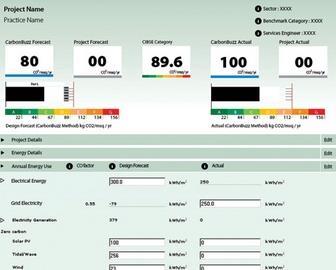A new online database of buildingsÔÇÖ energy and emissions performance, before and after completion, will compare the predictions with reality ÔÇô and give engineers the chance to teach architects a thing or two about sustainable development.
Engineers will be able to benchmark the energy consumption and emissions of their designs against similar schemes under a new CIBSE/RIBA initiative called CarbonBuzz. The online platform, due to launch on 5 November, will create a sector-by-sector monitor of UK buildingsÔÇÖ energy use and provide the two institutions with a framework for good practice.
CIBSE and RIBA are urging UK designers and engineers to contribute information to the platform, which can be done anonymously if preferred, to help raise awareness of emissions of building types ÔÇô schools, offices, and so on.
CarbonBuzz emerged from a collaboration between XCO2 Energy, a low-carbon consultancy, and the architect Aedas on the Green Book, a carbon footprinting initiative by the practice. Ricardo Moreira, director of XCO2, says they discovered a ÔÇťlack of understanding and available benchmarksÔÇŁ and saw the need to make architects more concerned with emissions.
CIBSE, RIBA and BRE came on board as main project partners. A funding bid was submitted to UrbanBuzz, a University College London initiative that promotes sustainable buildings. ÔÇťWith the funding we have a great opportunity to get architects to ask their engineers important questions earlier on in the process and at the same time get engineers to question themselves about the energy consumption of buildings early on.ÔÇŁ
Bill Bordass of the Usable ║├╔ź¤╚╔˙TVs Trust, a charity which promotes greener buildings, was approached in the early stages of CarbonBuzz to be an adviser. ÔÇťAedas came to me with the idea about a year ago and I advised them to contextualise it with what was happening with energy certification and with CIBSE,ÔÇŁ he says.
ÔÇťThereÔÇÖs a big problem internationally in reporting the performance of buildings. Conventions are not transparent. So Carbon-Buzz is a brick in the wall. I donÔÇÖt think it answers all the questions but itÔÇÖs certainly a useful step forward. There needs to be clearer conventions for services engineers to report to architects. The main thing architects know these days is whether a building fits the regulations; thatÔÇÖs as far as their concern goes, and why CarbonBuzz was initiated. The second aspect of this project is to get engineers comparing their options.ÔÇŁ
The database asks a series of questions about whatÔÇÖs going into the design of the building and generates a breakdown which tracks energy consumption, both predicted and post-construction, classifying it under different building types. It also provides the option of a breakdown for different energy types and sources of use in the building. Data will be handled confidentially unless the originators agree that the information can be released.
Hywel Davies, CIBSE technical director, says: ÔÇťCarbonBuzz is all about trying to get architects to take carbon seriously. Some architects have been trying to do so for quite some time, personally and in their practices, but the difficulty theyÔÇÖve had is that thereÔÇÖs a certain amount of engineering needed, plus sometimes the clients donÔÇÖt want to talk to the engineer at that early stage.
ÔÇťMany architects havenÔÇÖt been so committed, perhaps because they havenÔÇÖt seen it as important or they havenÔÇÖt known where to go to get advice. CarbonBuzz is trying to say to architects, ÔÇśHow can we help you and what tools can we give you to reduce the emissions of your architecture?ÔÇÖ ÔÇŁ
The tool has been tested by a number of companies, including Mott MacDonald and BDP. Ahead of the launch next month, an open invitation was issued to engineering and architectural practices to attend pilot workshops at RIBA headquarters in London, on 1-3 October.
Davies was among those due to attend. ÔÇťThe crux of the workshops is sharing the concept and sharing our enthusiasm so that people go away feeling that this is something they want to get involved in. RIBA has a Carbon Conscious Practice scheme to recognise good practice, CIBSE has its low carbon consultants, and itÔÇÖs a great opportunity to raise awareness of both and get people to join in.ÔÇŁ
Discussions are continuing about the future funding of the project. This will be shaped by the success of the pilot scheme and the response from the industry. Davies says: ÔÇťIt canÔÇÖt continue on a long-term basis with institutional funding. We have got some ideas and we think we can keep it running long term.ÔÇŁ
to access the CarbonBuzz website.
Get the buzz
Engineers and architects will help to build the database by submitting details of their schemes. Design forecast data relates to Part L or M&E report values. Ideally, details of services engineer and analysis software used would also be noted. Post-completion data can be obtained through energy bills, results of a post-occupancy evaluation, TM22 energy assessment or similar. For both forecast and completion, two main categories are required:
PROJECT DETAILS
Name
Completion date
Gross internal floor area
Sector and CIBSE benchmark category
Location
Services engineer
Analysis software/method
Occupancy details
Ventilation strategy
ENERGY DETAILS (kWh/year)
Energy source:
Electric: grid electricity
On-site generation
Non-electric: mains gas
Zero/low-carbon source
Energy use (where possible):
Electric: space heating
Hot water
Cooling and plant
Lighting
Unregulated in Part L, eg server rooms, etc
Non-electric: heating
Hot water
Other
Source
║├╔ź¤╚╔˙TV Sustainable Design






















No comments yet